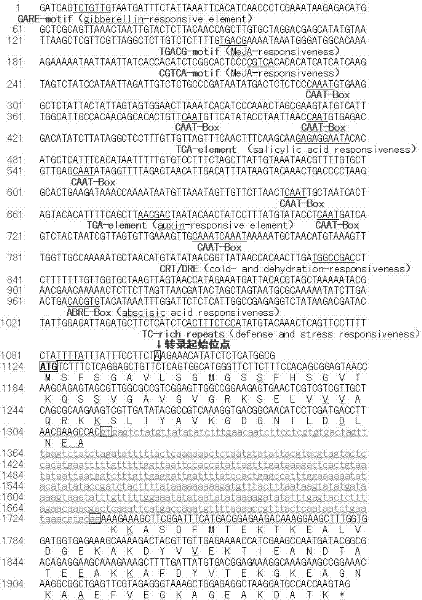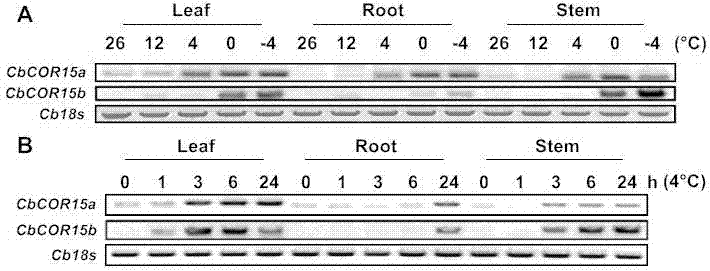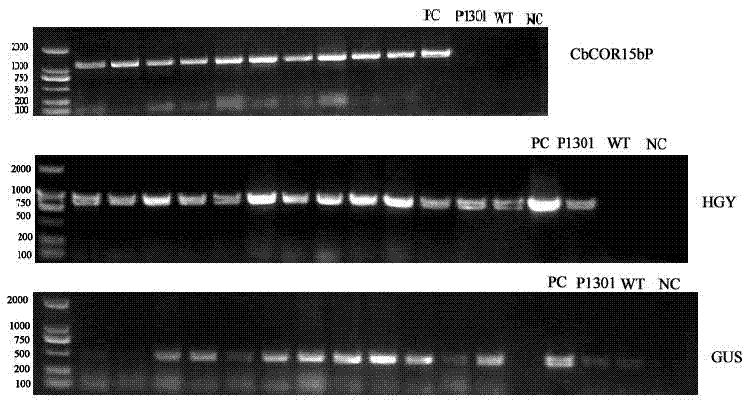Capsella bursapastoris cold regulated protein gene promoter and application thereof in plant cold resistance improvement
A cold-regulatory protein and promoter technology, which is applied in the fields of molecular biology and plant genetic engineering, can solve the problems of few cold-inducible specific promoters and no cold-tolerant plants have been found, and achieve the effect of improving cold resistance
- Summary
- Abstract
- Description
- Claims
- Application Information
AI Technical Summary
Problems solved by technology
Method used
Image
Examples
Embodiment 1
[0024] Example 1 Isolation and identification of CbCOR15bP.
[0025] 1. Cultivation of shepherd's purse seedlings
[0026] The shepherd's purse seeds come from Shanghai Magnolia Vegetable Seed Co., Ltd. After the shepherd's purse seeds are sterilized, they are sown in the 0 The culture tank of the culture medium was placed at 25° C. for 4 weeks, and the photoperiod was 16 hours of light and 8 hours of darkness.
[0027] 2. Cloning of the promoter sequence
[0028] The promoter sequence of CbCOR15b gene of shepherd's purse was amplified by Genome walking technology. Experimental operation according to Universal GenomeWalker TM Kit (CLONTECH) manual. After the Genome walking library of shepherd's purse was built, two primers were designed according to the open reading frame (ORF) of the cDNA sequence of the COR15b gene: CbCOR15bF1: 5'-GATCAGTCTGTTGTAATGA-3' (denoted as SEQ ID NO. 2) and CbCOR15bF2: 5' - ACCATCG CCATGAGAGATATG-3' (denoted as SEQ ID NO. 3), cooperates with...
Embodiment 2
[0030] Example 2 CbCOR15b Expression characteristics under cold induction and cold acclimatization treatments.
[0031] 1. Planting and handling of shepherd's purse
[0032] Take an appropriate amount of fresh shepherd's purse seeds, after aseptic treatment, place them in a pre-configured MS medium (MS powder 4.41g / L, sucrose 30g / L, agar powder 8.5g / L) sterile culture tank, and cultivate under light at 26°C. Cold acclimation treatment The seedlings 4 weeks after seed germination were selected, and the shepherd's purse seedlings were treated according to the temperature gradient of 26°C (4d), 12°C (4d), 4°C (4d), 0°C (2h), -4°C (2h). Induction treatment Seedlings 4 weeks after seed germination were selected, and shepherd's purse seedlings were treated in a gradient of 0h, 1h, 3h, 6h, 12h, 24h, and 48h at 4°C, and total RNA was extracted from leaves, stems, and roots.
[0033] 2. RNA extraction
[0034] RNA extraction was performed according to the operating procedures of th...
Embodiment 3
[0039] Example 3 Analysis of low temperature induction activity of shepherd's purse COR15bP promoter.
[0040] In this example, the cloned CbCOR15bP sequence plus restriction sites Bgl II and Pst Ⅰ. Connect to the pCAMBA1301 vector (gifted by CAMBIA [the Center of the Application of Molecular Biology to International Agriculture, Australia] in Australia) to construct a plant expression vector that drives the GUS gene. Transformed tobacco experiments showed that CbCOR15bP can enhance the expression of GUS gene under low temperature induction. Therefore, CbCOR15bP has a good application prospect in crop cold-resistant genetic engineering breeding.
[0041] Construction of expression vectors.
[0042] In this embodiment, construct the expression vector pCAMBA1301-COR15bP-GUS
[0043] The CaMV35S promoter contained in the commercialized plant expression vector pCAMBA1301 was excised and connected into shepherd's purse COR15bP to regulate the expression of GUS gene. The co...
PUM
 Login to View More
Login to View More Abstract
Description
Claims
Application Information
 Login to View More
Login to View More - R&D
- Intellectual Property
- Life Sciences
- Materials
- Tech Scout
- Unparalleled Data Quality
- Higher Quality Content
- 60% Fewer Hallucinations
Browse by: Latest US Patents, China's latest patents, Technical Efficacy Thesaurus, Application Domain, Technology Topic, Popular Technical Reports.
© 2025 PatSnap. All rights reserved.Legal|Privacy policy|Modern Slavery Act Transparency Statement|Sitemap|About US| Contact US: help@patsnap.com



